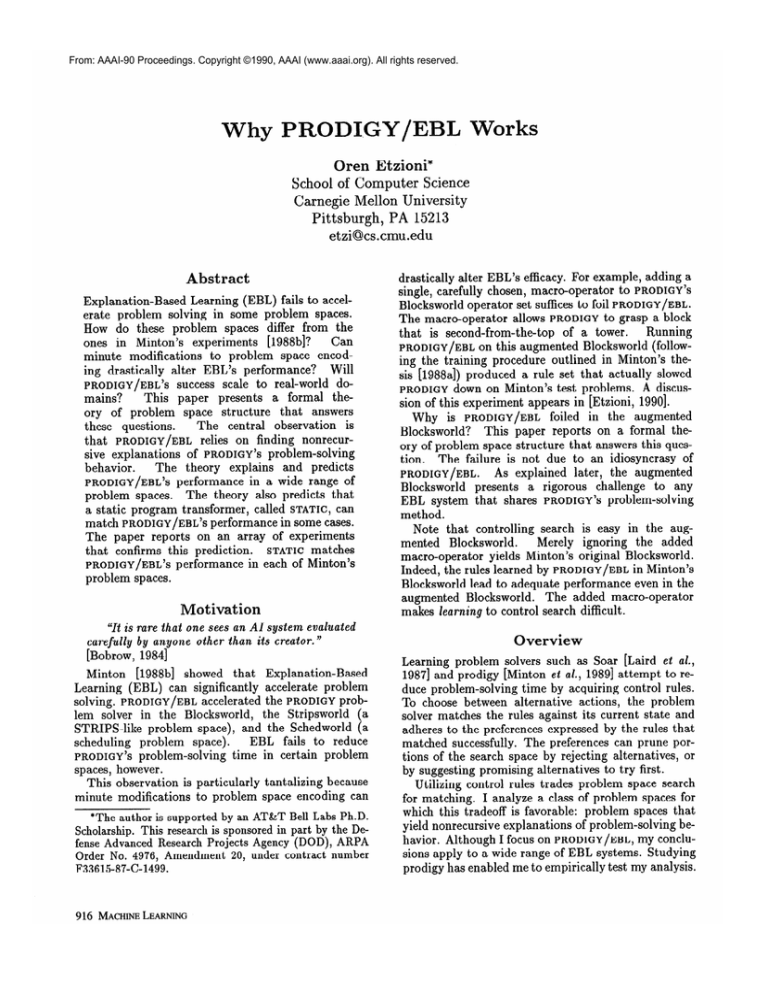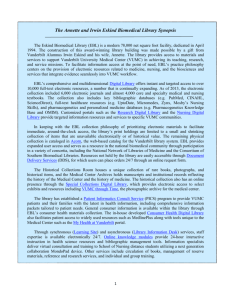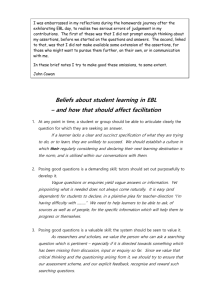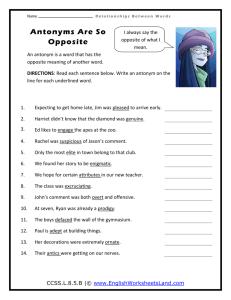
From: AAAI-90 Proceedings. Copyright ©1990, AAAI (www.aaai.org). All rights reserved.
Why
PRODIGY/EBL
Works
Oren Etzioni*
School of Computer Science
Carnegie Mellon University
Pittsburgh, PA 15213
etzi@cs.cmu.edu
Abstract
Explanation-Based
Learning (EBL) fails to accelerate problem solving in some problem spaces.
How do these problem
spaces differ from the
Can
ones in Minton’s
experiments
[1988b]?
minute modifications
to problem
space encodWill
ing drastically
alter EBL’s
performance?
PRODIGY/EBL'S
success scale to real-world
domains?
This
paper
presents
a formal
theory of problem
space structure
that answers
The
central
observation
is
these questions.
that PRODIGY/EBL
relies on finding nonrecursive explanations
of PRODIGY'S problem-solving
behavior.
The theory
explains
and predicts
PRODIGY/EBL'S performance
in a wide range of
problem spaces.
The theory also predicts that
a static program transformer,
called STATIC, can
match PRODIGY/EBL'S performance in some cases.
The paper reports on an array of experiments
that confirms this prediction.
STATIC matches
PRODIGY/EBL'S performance
in each of Minton’s
problem spaces.
Motivation
“It is rare that one sees an AI system evaluated
carefully by anyone other than its creator.”
[Bobrow, 19841
Minton
[1988b]
showed that
Explanation-Based
can significantly
accelerate
problem
Learning
(EBL)
solving. PRODIGY/EBL
accelerated the PRODIGY problem solver in the Blocksworld,
the Stripsworld
(a
STRIPS-like
problem space), and the Schedworld (a
EBL
fails to reduce
scheduling
problem
space).
PRODIGY'S problem-solving
time in certain problem
spaces, however.
This observation
is particularly
tantalizing because
minute modifications
to problem space encoding can
*The author is supported
by an AT&T Bell Labs Ph.D.
Scholarship.
This research is sponsored
in part by the Defense Advanced
Research Projects
Agency (DOD),
ARPA
Order No. 4976, Amendment
20, under contract
number
F33615-87-C-1499.
9 16 MACHINELEARNING
drastically alter EBL’s efficacy. For example, adding a
single, carefully chosen, macro-operator
to PRODIGY'S
Blocksworld operator set suffices to foil PRODIGY/EBL.
The macro-operator
allows PRODIGY to grasp a block
Running
that is second-from-the-top
of a tower.
PRODIGY/EBL on this augmented Blocksworld (following the training procedure outlined in Minton’s thesis [19SSa]) produced a rule set that actually slowed
PRODIGY down on Minton’s test problems.
A discussion of this experiment
appears in [Etzioni, 19901.
Why is PRODIGY/EBL
foiled in the augmented
Blocksworld ? This paper reports on a formal theory of problem space structure that answers this question.
The failure is not due to an idiosyncrasy
of
As explained
later, the augmented
PRODIGY/EBL.
Blocksworld
presents
a rigorous
challenge
to any
EBL system that shares PRODIGY'S problem-solving
method.
Note that controlling
search is easy in the augMerely ignoring
the added
mented
Blocksworld.
macro-operator
yields Minton’s original Blocksworld.
Indeed, the rules learned by PRODIGY/EBL in Minton’s
Blocksworld lead to adequate performance
even in the
The added macro-operator
augmented
Blocksworld.
makes learning to control search difficult.
Overview
Learning problem solvers such as Soar [Laird et al.,
19871 and prodigy [Minton et al., 19891 attempt to reduce problem-solving
time by acquiring control rules.
To choose between alternative
actions,
the problem
solver matches the rules against its current state and
adheres to the preferences expressed by the rules that
matched successfully.
The preferences can prune portions of the search space by rejecting alternatives,
or
by suggesting promising alternatives
to try first.
Utilizing control rules trades problem space search
for matching.
I analyze a class of problem spaces for
which this tradeoff is favorable:
problem spaces that
yield nonrecursive explanations
of problem-solving
behavior. Although I focus on PRODIGY/EBL, my conclusions apply to a wide range of EBL systems. Studying
prodigy has enabled me to empirically test my analysis.
Since the cost of matching a control rule grows exponentially
with the size of that rule, acquiring control rules can fail to accelerate problem solving. This
problem has been dubbed the utility problem [Minton,
1988b]. The match cost of a bounded-size
control rule
is polynomial in the problem size, however. Thus, the
utility problem could be solved by bounding the size
of the control rules acquired.
Unfortunately,
the size of EBL’s
rules is not
Why is that?
When
EBL’s
explanabounded.
tions are recursive,
distinct rules are learned at every recursive depth to which the explanations
are expanded.
This is known as the generalization-to-N
problem [Cheng and Carbonell,
1986, Prieditis,
1986,
Shavlik and DeJong, 19851. In the Blocksworld,
for example, PRODIGY/EBL
learns distinct rules for clearing
the bottom block of a two-block tower, a three-block
tower, and so on. This is problematic
in two regards.
First, after learning from examples of two, three, and
four block towers, PRODIGY/EBL
will fail to generalize to five-block towers; in fact, any finite rule set will
fail to cover all possible Blocksworld
problems.
Second, the match cost of the rules formed in this manner
grows exponentially
with the problem size.
Recursion abounds in problem spaces, even ones as
simple as the Blocksworld.
How is PRODIGY/EBL
able
to acquire effective control knowledge then? The anrelies on finding nonrecursive
swer is: PRODIGY/EBL
explanations
of PRODIGY's problem solving behavior.
Nonrecursive explanations
provide a natural, problemspace-specific
bound on rule size. The cost of matching
rules based on nonrecursive explanations
is polynomial
in the size of the problems encountered.
PRODIGY/EBL'S
ability to learn from failure allows it to find nonrecursive
explanations
even when
PRODIGY'S solutions are recursive.
When PRODIGY'S
failure paths are recursive, PRODIGY/EBL
can sometimes learn from success.
When both success and
failure can only be explained
recursively,
however,
PRODIGY/EBL
is foiled.
PRODIGY/EBL'S
explanations
are not
arbitrary
The explanations
mirror the structure
of
proofs.
PRODIGY'S problem
spaces.
I formalize
this notion by defining the problem space graph (PSG),
a
compact
representation
of problem space structure.
PRODIGY/EBL'S explanations
correspond to PSG subgraphs. PRODIGY/EBL
finds nonrecursive explanations
only when the appropriate nonrecursive subgraphs are
present in the PSG. The absence of such subgraphs
from the augmented Blocksworld foils PRODIGY/EBL.
A program that does not utilize training examples
can form roughly the same rules as PRODIGY/EBL.
The program,
called STATIC, detects the PSG subgraphs that correspond to nonrecursive
explanations,
and extracts
control
rules directly
from the subgraphs. STATIC matches PRODIGY/EBL'S performance
in Minton’s problem spaces. This surprising result connonrecursive
problem space
firms my central claim:
structure
is the primary
source of PRODIGY/EBL'S
power.
The following section shows how recursive explanations lead to rules whose size cannot be bounded.
The subsequent section defines the PSG, and formalizes the notion of problem space structure.
I then
demonstrate
how EBL’s performance
can be analyzed
in terms of the PSG. I describe STATIC briefly, and
evaluate its performance
experimentally.
A discussion
of generalization-to-N
and other related work follows.
Recursive
Explanations
This section shows that the size of PRODIGY/EBL'S
rules cannot be bounded due to recursive explanaPRODIGY/EBL
explains how choices made by
tions.
the PRODIGY problem solver led to success, failure, or
goal interaction.
The explanations
translate portions
of PRODIGY'S problem-solving
trace into logical proofs.
The proofs contain domain-specific
axioms that correspond to PRODIGY'S operators.
When a trace contains recursive operator application, the corresponding
proof is thus recursive. The depth of the recursion in
the proof equals the depth of operator recursion in the
trace. Distinct control rules are learned at each recursive depth.
Moreover, larger rules are learned as the
recursive depth increases.
In the Blocksworld,
for example, clearing a block is
a recursive operation.
Clearing the bottom block of an
N-block tower requires N-l calls to the UNSTACK operator. As a result, PRODIGY/EBL forms distinct rules
for the two-block tower, the three-block
tower, and so
on. Each rule only applies to towers of a given height.
As the state size increases, and increasingly taller towers are possible, more rules are necessary for guiding
PRODIGY to choose UNSTACK. Recursive explanations
are not unique to learning from success.
Failure and
goal interaction
can require recursive explanations
as
well.
As PRODIGY
encounters
problems
which require
deeper recursions,
EBL will form successively
larger
rules. When the size of the problems is not bounded,
the size of the rules learned from recursive explanations cannot be bounded either. In the worst case, the
size of the learned rules scales linearly with the size of
PRODIGY'S problems.
The size of rules learned from
nonrecursive explanations,
in contrast, is bounded by
the number of predicates and operators in the problem
space. Of course, the size of nonrecursive explanations
can scale up as we consider increasingly larger problem
spaces. The size is bounded, however, as PRODIGY encounters larger and larger problems in a fixed problem
space.
Problem
Space Graphs
PRODIGY/EBL'S explanations
mirror the structure
of
PRODIGY'S problem space.
Successfully
clearing a
block has a recursive explanation
because plans that
achieve the clear
goal are recursive.
Thus, whether
ETZIONI9 17
the size of PRODIGY/EBL’S rules is bounded depends
on where recursion occurs in the problem space. I formalize this notion using PSGs. A PSG is an AND/OR
graph which represents the goal/subgoal relationships
of any
in a problem space. The PSG is independent
state information;
it is derived from the problem space
definition. EBL’s explanations
correspond to PSG subgraphs.
Since PSGs make recursion explicit, they facilitate finding nonrecursive explanations.
This section
introduces PSGs, and describes their relation to EBL’s
explanations.
A PSG consists of disjoint subgraphs each of which
is rooted in a distinct goal literal.
Each subgraph is
derived by symbolically
back chaining on the problem
space’s operators from the root. The root literal is connected via o&links
to all the operators that achieve
the literal, and each operator is connected via ANDlinks to its preconditions.
Thus, the PSG nodes are
an alternating
sequence of (sub)goals
and operators;
the PSG edges are either AND-links or OR-links. Figure 1 depicts the Blocksworld PSG subgraph rooted in
(holding
block).
The graph is directed and acyclic.
Two operators
that share a precondition
have ANDlinks to the same node, so the graph is not a tree.
from constraints
on legal states, and the observation
that literals on the goal stack are not true in the current state. For example, PRODIGY is either holding a
block or its arm is empty. Hence, if the current goal is
(holding
block),
then arm-empty must be true.’
The PSG
1: The holding
PSG
2: The Failure
Subgraph
for UNSTACK.
Subgraph.
An operator achieves a goal if the operator’s effects
successfully unify with the goal. This unification imposes codesignation
constraints between the arguments
to the goal literal, and the operator’s
variables.
The
operator’s
preconditions
are partially instantiated
to
reflect these constraints.
For example, since the goal is
(holding
block),
UNSTACK’S first precondition is (on
block
<vi>).
The graph terminates in one of four cases: A leaf literal (labeled gs-cycle) already appears on a path from
the leaf to the root. This is known as a goal-stack cycle.
A literal’s predicate (labeled recurs) recurs on a path to
the root with no goal-stack cycle. No operators unify
with a literal (this never happens in the Blocksworld).
Finally, a literal (labeled holds) is known to be true
given the current goal stack. This fact can be inferred
9 18 MACHINELEARNING
Proofs
The notion of representing
programs
(or problem
spaces) as graphs is well-known in computer science
(see, for example, [Kowalski, 19741). It is surprising to
note, however, that PRODIGY/EBL’S proofs correspond
to PSG subgraphs.
PRODIGY/EBL’S failure proofs, for example, have the
following flavor: an operator cannot be executed because one of its preconditions
cannot be achieved. A
precondition
cannot be achieved because all of the operators that could potentially
achieve it cannot be executed and so on. Each proof “explains” a failure by
an alternating
series of existentially
and universally
quantified statements
about the relevant preconditions
and operators.
Success proofs have the same nature,
but the quantifiers are reversed. These alternating sequences correspond to the alternating sequences of operator and precondition
nodes in the PSG.
For example, UNSTACK fails because one of its preconditions,
(on block
<vi>),
cannot be achieved
in the context of (holding
block).
on cannot be
achieved because all of the relevant operators (STACK
is the only one) cannot be executed. STACK cannot be
executed because one of its preconditions,
(holding
block),
results in a goal-stack cycle. This proof mirrors the subgraph
in Figure 2. The example illustrates the correspondence
between PSG subgraphs and
PRODIGY/EBL’s explanations.
A formal exposition of
this correspondence
appears in [Etzioni, 19901.
Figure
Figure
and EBL’s
Recursion
in the PSG occurs at the nodes labeled
recurs. An explanation
is recursive only if one of the
nodes in its corresponding
PSG subgraph is labeled recurs. Thus, the PSG provides an easy means of avoiding recursive proofs.
The only source of recursion in the holding
PSG is
the application
of UNSTACK to achieve clear.
Proving that an operator can achieve (holding
block)
requires demonstrating
that block can be cleared-a
recursive proof. Hence, in the Blocksworld, learning from
‘This statement
and the PSG’s depiction
are slightly
simplified.
Since the holding
goal is satisfied only when a
particular
block is held, (arm-empty)
will be false when
Expanding
the
PRODIGY is grasping a different block.
(arm-empty)
node one step further, however, reaches the
precondition
(holding <v2>) which is guaranteed to be
true in this context.
success results in recursive explanations
and overlyspecific rules.
Proving
that
an operator
will fail to achieve
holding,
however, does not require mentioning
clear
at all. PICK-UP fails if (on-table
block)
is not true;
UNSTACK fails if (on block
<vi>)
is not true.
As
the PSG indicates, a goal-stack cycle results in either
case. This occurs in Blocksworld problems of any size.
Thus, EBL is able to form general rules by analyzing
failures.
In fact, five failure proofs yield all the control rules necessary to make appropriate
operator and
bindings choices. The failure proofs are nonrecursive,
yielding rules that are compact, general, and cheap-tomatch.
The Blocksworld
example illustrates
an important
point.
The nature of PRODIGY/EBL'S rules depends
both on the problem space and on the target concept
employed to acquire the rules.
Proofs based on distinct target concepts pick out distinct PSG subgraphs.
In the example,
the success subgraphs
are recursive
whereas the failure subgraphs
are not.
This observation suggests a criterion for choosing which target
concept to utilize in learning control knowledge: learn
from the target concept that yields a nonrecursive
proof.
STATIC, described in the following section, employs this
criterion to choose which control rules to form.
PRODIGY/EBL
does not employ this criterion.
In
the case of holding,
for example, it learns from both
relies on its utility
success and failure. PRODIGY/EBL
analysis mechanism to weed out ineffective rules.
Predicting
EBL’s
Performance
In the Blocksworld,
nonrecursive
explanations
can be
found for most problem-solving
phenomena.
When explaining the success of an operator
is recursive,
explaining the failure of its sibling operators
is not.
Consequently,
given a sufficient number of examples,
PRODIGY/EBL
is able to accelerate
PRODIGY significantly on Blocksworld problems.
In the augmented Blocksworld,
by way of contrast,
recursion occurs both on the route to failure and to
success.
Consider,
for example,
choosing UNSTACK
to achieve the goal (holding
block)
when the block
is on the table.
This path is doomed to failure in
both Blocksworlds.
In the Blocksworld,
the failure can
be explained nonrecursively
since trying to achieve on
leads to a goal-stack cycle immediately
(Figure 2).
In the augmented
Blocksworld,
in contrast,
on can
be achieved by the macro-operator
added to PRODIGY'S
operator set. The macro-operator
allows PRODIGY to
grasp the block that’s second-from-the-top
of a tower.
The top block lands on the block that is third-from-thetop as a side effect. Thus, PRODIGY has another means
of achieving on which does not immediately
cause a
Since prodigy explores the recurgoal-stack
cycle.
sive path that begins with the macro-operator
before
failing, PRODIGY/EBL
is forced to analyze that path
in order to explain PRODIGY'S failure.
Consequently,
explaining the failure of UNSTACK in the augmented
Blocksworld is recursive.
This
example
illustrates
how adding
a macrooperator
to the Blocksworld
led to PRODIGY/EBL'S
lackluster performance.
Problem spaces that yield only
recursive explanations,
relative to the learner’s target
concept and the problem solver’s search method, will
challenge PRODIGY/EBL,
Soar, and a wide range of
EBL systems.
Whether
a problem space yields recursive or nonrecursive explanations
can be determined
by analyzing the problem space’s PSG.
EBL will accelerate
problem solving when the PSG yields nonrecursive
explanations. 2 Hence, analyzing PSGs is a powerful
methodology
for predicting and explaining EBL’s performance.
I return to this idea in the conclusion of the
paper.
Static Analysis
of PSGs
Thus far I have argued that PRODIGY/EBL
exploits
nonrecursive proofs to extract cheap but effective control rules, and that the existence
of these proofs
is a function
of both problem space structure
and
PRODIGY/EBL's “prOOf strategies”
or target concepts.
Furthermore,
I have shown that nonrecursive
proofs
correspond to nonrecursive PSG subgraphs.
It follows that we can extract effective control rules
directly from the PSG. To test this prediction I wrote
the STATIC program which forms control rules by applying a select subset of PRODIGY/EBL'S proof strategies directly to the PSG. Given a problem space encoded as a set of operators and a set of constraints on
legal states, STATIC constructs the PSG corresponding
to that problem space.
The PSG subgraph in Figure 1 depicts an instance of STATIC's PSG data structure. STATIC embarks on a depth-first search for nonrecursive PSG subgraphs,
and extracts
control rules
from the nonrecursive subgraphs it finds. STATIC only
forms control rules when the nonrecursive learning criterion, articulated
earlier, is met. No examples, rule
compression,
or utility analysis are used. A sketch of
STATIC'S algorithm for analyzing failure appears in Table 1. STATIC'S algorithm for analyzing success is analogous.
To illustrate the algorithm’s
execution consider the
failure subgraph in Figure 2. STATIC computes the
fc, or failure condition, and label fields of each node
STACK, at the right of the subgraph, is
in postorder.
labeled failure, and its fc is ogs((holding
block)).
That is, sTAcI<(block,<vl>)
will fail when (holding
block)
is on PRODIGY'S goal stack.
The fc of (on
<vi>) is the same. UNSTACK'S only failed preblock
condition is (on block <vi>).
UNSTACK is labeled
failure and its fc is ogs( (holding
block))
Al(on
20f course, in cases where different bounds on the cost of
matching EBL’s
problem solving
rules can be enforced,
as well.
EBL will accelerate
ETZIONI919
Input: operator set + constraints on legal states.
Output: Operator rejection rules.
;;; ops(lit)
;;; fc(z)
refers to the operators
refers to the conditions
that achieve
under
which
lit.
I fails.
Main loop:
for lit in goal-lits do
Create PSG subgraph rooted in lit (e.g., Figure 1).
for o in ops(lit) do LABEL-OP(o).
Find operators labeled failure and form rejection
rules whose antecedents are the operators’ fcs.
;;;failure-labels:
;;;Additional
{failure,
labels:
;;; p E fail-precs(o)
;;; ogs(p)
gs-cycle,
{success,
unachievable}.
holds,
iff p E ptecs(o)
recurs}.
A label(p)
is true when p is on prodigy’s
E failure-labels.
goal-stack.
procedure LABEL-OP(o)
for unlabeled lit in precs(o) do LABEL-LIT(lit).
if Tempty(fail-precs(o)) then {label(o) + failure;
if 3p E fail-precs(o) s.t. label(p)=gs-cycle then fc(o) c ogs(p).
else for p in fail-precs(o) do fc(o) c fc(o) V(fc(p)
A up).}
else if 3p E precs(o)
s.t. label(p)=recurs then label(o) + recurs.
else label(o) + success.
STATIC matches
PRODIGY/EBL’S
performance
in
Minton’s problem spaces as shown in Figure 3. The
figure depicts cumulative running times for PRODIGY
given STATIC’S rules, PRODIGY/EBL’S
rules, and rules
written by human experts.
EBL’s rules, the human
rules, the randomly generated problem sets, and the
cumulative graphs format are taken from Minton’s experiments.
The time to solve each problem was limited to 150 CPU seconds.
Several Schedworld problems could not be solved within this time limit using
one or more of the rule sets. All such problems were
STATIC outexcluded from the Schedworld
graphs.
slightly in all three problem
performed PRODIGY/EBL
spaces. However, all the rule sets accelerated PRODIGY
significantly.
Nc------#c
n
Q- - -0
Prodigy+EBL rules.
Prodigy+STATIC rules.
Prodigy+human rules.
160
140
Blocksworld.
120
;;;LABEL-LIT(lit)
is never called
;;;o E fail-ops(lit)
iff o E ops(Zit)
100
80
when ops(lit)=NIL.
A label(o)
=
failure.
procedure LABEL-LIT(lit)
for o in ops(lit) do LABEL-OP(o).
if 30 E ops(Zit) s.t. label(o)=success then label(lit) + success.
else if 30 E ops(Zit) s.t. label(o)=recurs then label(lit) c recurs.
else {label(lit) + failure;
for o in fail-ops(lit) do fc(lit) t- fc(lit) A fc(o).}
60
40
20
0
350
Table
1:
STATIC’S
algorithm
for analyzing
0
400
Stripsworld.
.**
failure.3
block
<vi>).
Thus, STATIC forms a rule that rejects
when PRODIGY’S
goal is (holding
block)
and (on block
<vi>)
is false. An analogous rule rejects PICK-UP when (on-table
block)
is false. Since
both UNSTACK and PICK-UP require achieving (clear
block),
a precondition
that is achieved recursively, no
rules are learned from success.
To acquire goal-ordering
rules STATIC considers all
possible goal pairs.
For each pair, STATIC checks
whether achieving one goal necessarily
clobbers the
other goal.
If so, STATIC tells PRODIGY to achieve
the clobbering
goal first.
The clobbering
can be
avoided in this manner.
For example, achieving (on
block1
block2)
clobbers (holding
block3)
because
(holding
blockl)
is a necessary precondition
of (on
block1
block2)
and only one block can be held at any
giVen time.
COnSeqUently,
STATIC infOrmS
PRODIGY
that on should be achieved before holding.
Schoppers [Schoppers,
19891 reports on a related technique
for detecting goal conflicts.
See [Etzioni, 19901 for a
comparison,
and a complete discussion of STATIC.
UNSTACK
3Tlie V, A operators are not applied to their arguments.
Thus, logical formulae are incrementally constructed by the
above procedures. Treatment of failures due to inconsistent
variable bindings is omitted for brevity.
920
MACHINE LEARNING
400
350
300
E
Schedworld.
EBL: 8 Unsolved.
Number of Problems
Performance
in the Blocksworld,
and the Schedworld.
STATIC’S
the Stripsworld,
Since STATIC is biased to only form rules based on
nonrecursive
PSG subgraphs,
it does not necessarily
form a superset of PRODIGY/EBL’S
rules. On Minton’s
problem spaces, for example,
STATIC
acquired only
one rule based on analyzing successful paths whereas
PRODIGY/EBL
formed thirteen.
STATIC does rely on
spaces,
however.
“success rules” in other problem
PRODIGY/EBL'S rule sets contained a variety of overlyspecific rules that STATIC did not form. The overlyspecific rules were formed when PRODIGY/EBL retained
features of its training
examples,
such as recursion
Finally, STATIC formed useful
depth, unnecessarily.
rules that PRODIGY/EBL
missed, when PRODIGY/EBL
did not encounter the requisite examples in its training
sequences.
Prieditis [1988] and van Harmelen & Bundy [1988]
have pointed to the affinity between partial evaluation and EBL. Indeed, STATIC constructs
the PSG by
partially evaluating PRODIGY'S problem space definition. However, the control rules acquired modify the
order in which PRODIGY considers operators and subgoals. These reordering transformations
are not part
of the usual arsenal of partial evaluators.
Thus, STATIC
and EBL’s impact on PRODIGY is more appropriately
viewed as program transformation.
Caveats
STATIC will not match PRODIGY/EBL'S performance
in
can exploit the distribution
every case. PRODIGY/EBL
of problems encountered
by PRODIGY whereas STATIC
STATIC is particularly
sensitive to the concannot.
straints on legal states that define the PSG. If some of
the constraints
are omitted, STATIC will analyze various impossible paths and form a host of unnecessary
rules. Finally, STATIC only utilizes a select subset of
PRODIGY/EBL'S proof strategies.
For example, STATIC
only searches for pairwise goal interactions,
and will
overlook more complex ones. Although learning from
complex goal interactions
can be useful, analyzing such
interactions
often leads PRODIGY/EBL
to form highly
specific rules that are expensive to match.
STATIC'S
scope is restricted (relative to PRODIGY/EBL'S) for two
reasons:
to avoid potentially
expensive rules, and to
keep the static analysis tractable.
STATIC is not meant as an alternative to EBL. A hybrid algorithm consisting of some static preprocessing
followed by EBL may well prove most effective. STATIC
appears in this paper merely to empirically
demonstrate the utility and importance
of nonrecursive
PSG
subgraphs for acquiring control knowledge.
Related
Work
Formal analyses of EBL have been reported by [Cohen,
1989, Greiner and Likuski,
1989, Mahadevan
et al.,
1988].
None of these analyses point to nonrecursive
explanations
as EBL’s primary source of power.
Subermanian
& Feldman [1990] show that for hornclause theories in which recursion is structural and the
cost of choosing which rule to apply is bounded, learning from recursive explanations
is unlikely to reduce
theorem-proving
time. They do not consider learning
from failure and goal interaction,
representing problem
spaces as graphs, or statically
deriving nonrecursive
Although a simple complexity
analysis
explanations.
suffices to argue against learning from recursive explanations via EBL (the overhead of utilizing rules learned
from such explanations
is exponential
in the depth of
the recursions encountered),
Subermanian
& Feldman
develop an elaborate cost model of horn-clause theorem
proving. This detailed model is motivated by Subermanian & Feldman’s
broader project which seeks to
“quantitatively
estimate” the cost of inference.
Remarkably,
despite our focus on different EBL algorithms and different problem spaces, we reached similar conclusions.
This provides further confirmation
of
the ideas in both papers.
Research on generalization-to-N
(e.g., [Cohen, 1988,
Shavlik,
1990, Shell and Carbonell,
19891) has also
identified recursion as a problem for EBL. The focus of
that body of work, however, is on forming general rules
based on recursive explanations.
Shavlik’s program,
for example, learns horn-clauses
that retain recursive
calls in their antecedents.
Thus, a particular
recursive depth is not captured by the antecedent.
Unfortunately, the cost of utilizing such rules can increase
exponentially
with the depth to which the recursive
calls are expanded at run-time.
Letovsky’s
RECEBG
algorithm
[Letovsky, 19901 is
able to expand some recursive calls at compile-time
without forming overly-specific
rules.
RECEBG
expands recursive calls when it can prove, using structural induction, that the recursion will terminate.
Conclusion
Utilizing control rules trades problem space search for
matching.
I have analyzed a class of recursive problem spaces for which this tradeoff is favorable: problem
spaces that yield nonrecursive explanations
of problemsolving behavior.
Such explanations
yield boundedsize control rules.
The match cost of bounded-size
control rules is polynomial in the size of the problem
solver’s input.
I formalized
the notion of nonrecursive
explanations in terms of the problem space graph (PSG),
a
compact
representation
of problem space structure.
PRODIGY/EBL'S nonrecursive
explanations
correspond
to nonrecursive
PSG subgraphs.
EBL’s performance
can be analyzed using the PSG.
I demonstrated
the practical
import of this analysis via two experiments.
First,
I showed that
PRODIGY/EBL'S
performance
degrades
in the augmented Blocksworld,
a problem space robbed of its
nonrecursive
PSG subgraphs.
Second, I showed that
a program that extracts nonrecursive explanations
directly from the PSG matches PRODIGY/EBL'S performance on Minton’s problem spaces. Both experiments
lend credence to the claim that PRODIGY/EBL'S primary source of power is nonrecursive
problem space
structure.
The theory developed in this paper addresses the
ETZIONI921
questions posed at the outset.
PRODIGY/EBL'S efficacy in “real-world domains” depends on the structure of their PSGs.
Its success will scale to considerably larger and more complex domains whose encodings yield the appropriate
nonrecursive
PSG subgraphs.
Minor modifications
to the problem space’s
representation
can result in major changes to its PSG,
however.
Consequently,
PRODIGY/EBL'S performance
can vary as seemingly
minor changes are made to
the problem space representation.
Analyzing problem
spaces in terms of PSG structure enables us to understand this behavior.
The
problem
studied
in this paper
transcends
PRODIGY
and EBL.
Currently,
most learning
programs are halted after relatively short running times
(compared
with a human’s life-time of learning) lest
they swamp their performance
systems with massive
amounts of knowledge.
Any system that accumulates
knowledge over time must come to terms with the cost
of utilizing that knowledge.
Thus, it is not sufficient
to have a powerful learning algorithm.
The algorithm
must be appropriately
embedded in a performance system. This raises a host of challenging technical questions that research on memory organization,
selective
learning, and bounded match cost has to address. My
work is an instance of such research.
Acknowledgments
I would like to thank William
Cohen,
Scott Dietzen,
Haym Hirsh, Daniel Kahn,
Jack Mostow,
David Steier,
Prasad Tadepalli,
and Ralil Valdds-Perez
for comments
on
previous drafts.
The following
made invaluable
contributions to the ideas herein: Craig Knoblock,
Stan Letovsky,
Tom Mitchell,
Steve Minton, and Paul Rosenbloom.
Special thanks go to Steve Minton-whose
thesis work made
studying PRODIGY/EBL possible.
References
[Bobrow, 19841 Daniel G. Bobrow.
Retrospectives:
from the editor. Artificial
Intelligence,
23, 1984.
A note
[Cheng and Carbonell,
1986] P. Cheng
and J. G. Carbonell.
The FERMI
system:
Inducing iterative macroof the Fifth
operators
from experience.
In Proceedings
National
Conference
on Artificial
Intelligence,
pages
490-495,
1986.
[Cohen, 19881 William
W. Cohen.
Generalizing
number
and learning
from multiple
examples
in explanation
based learning. In Proceedings
of the Fifth International
Conference
on Machine
Learning,
pages 256-269,
1988.
[Cohen, 19891 William
W. Cohen.
mechanisms
which
proveably
Technical
Report
DCS-TR-254,
1989.
[Etzioni, 19901 Oren Etzioni.
Search Control.
PhD thesis,
1990. In preparation.
A Structural
Carnegie Mellon
[Greiner and Likuski, 19891 Russell
Likuski. Incorporating
redundant
liminary formal analysis of EBL.
922 MACHINELEARNING
Solution path caching
improve
performance.
Rutgers
University,
Theory
of
University,
Greiner
and
learned rules:
In Proceedings
Joseph
A preof the
Eleventh
International
telligence,
1989.
Joint
Conference
on Artificial
In-
[Kowalski, 19741 Robert A. Kowalski.
A proof procedure
Journal
of the ACM,
22:572using connection
graphs.
595, 1974.
[Laird et al., 19871 J. E. Laird, A. Newell, and P. S. Rosenbloom.
Soar: An architecture
for general intelligence.
Artificial
Intelligence,
33:1-64,
1987.
[Letovsky, 19901 Stanley Letovsky.
Operationality
criteria
for recursive
predicates.
In Proceedings
of the Eighth
National
Conference
on Artificial
Intelligence,
1990.
[Mahadevan
et al., 19881
Sridhar Mahadevan,
B. K. Natarajan,
and Prasad Tadepalli. A framework
for learning as improving
problemsolving performance.
In Proceedings
of the AAAI Spring
Symposium
on Explanation-Based
Learning,
1988.
[Minton et al., 19891 Steven Minton,
Jaime G. Carbonell,
Craig A. Knoblock,
Daniel R. Kuokka, Oren Etzioni, and
Yolanda
Gil. Explanation-based
learning:
A problemArtificial
Intelligence,
40:63-118,
solving perspective.
1989. Available
as techincd
report CMU-CS-89-103.
[Minton, 1988a] Steven Minton.
Learning
Eflective
Search
Control
Knolwedge:
An ExplanationBased Approach.
PhD thesis, Carnegie Mellon University, 1988. Available
as technical report CMU-CS-88-133.
[Minton, 1988131 Steven Minton.
Quantitative
results concerning the utility of explanation-based
learning. In Proceedings of the Seventh
National
Conference
on Artificial
Intelligence.
Morgan Kaufmann,
1988.
[Prieditis, 19861 A. E. Prieditis.
Discovery
of algorithms
from weak methods.
In Proceedings
of the international
meeting
on advances
in learning,
pages 37-52, 1986.
[Prieditis, 19881 A. E. P rre
* d’rt’1s. Environment-guided
program transformation.
In Proceedings
of the AAAI
Spring
Symposium
on Explanation-Based
Learning,
1988.
[Schoppers,
19891 Marcel
Joachim
Schoppers.
Represenof Reaction
Plans. PhD
tation and Automatic
Synthesis
thesis, University of Illinois at Urbana-Champaign,
1989.
Available as technical report UIUCDCS-R-89-1546.
[Shavlik and DeJong, 19851 Jude W. Shavlik and G. F. DeJong. Building a computer
model of classical mechanics.
In Proceedings
of the Seventh
Annual
Conference
of the
pages 351-355,
1985.
Cognitive
Science
Society,
[Shavlik, 19901 Jude W. Shavlik. Acquiring
recursive concepts
and iterative
concepts
with explanation-based
learning.
Machine
Learning,
5(l), 1990. To appear.
[Shell and Carbonell,
19891 Peter Shell and Jaime G. Carbonell. Towards a general framework for composing
disjunctive and iterative macro-operators.
In Proceedings
of
the Eleventh
International
Joint Conference
on Artificial
Intelligence,
1989. .
[Subermanian
and Feldman, 19901 Devika
Subermanian
and Ronen Feldman.
The utility of ebl in
of the Eighth
recursive domain theories.
In Proceedings
National
Conference
on Artificial
Intelligence,
1990.
[van Harmelen and Bundy, 19881 Frank van Harmelen and
Alan Bundy. Explanation-based
generalisation
= partial
evaluation.
Artificial
Intelligence,
36, 1988.
Research
Note.








